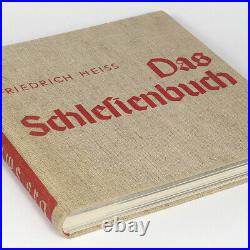
Silesia 1930s Photo Book with400 pictures + maps, 446 pages Poland Schlesien


Profusely illustrated Book about Silesia. I’m not aware of any other more comprehensive book from that time about Schlesien! There are hundreds of photos, charts and illustrations in this book. Hardcover in Full Linen / Cloth. 400+ rare b&w photos. Many maps, charts and illustrations throughout. Fine exterior and fine interior. Former owners stamp on front free endpaper, otherwise ok. The best copy I ever had of this rare book. All pages are complete and tight in the binding. Approx/Measurements: 10″ x 10-1/4″ 3.8 lbs. Published by Folk House. Table of contents [excerpt]. Country and people – The Silesian landscape with 19 maps – The language of the Upper Silesian. Silesia in German History – The Silesian area – The prehistory of Silesia – The German face of Silesia – The territorial development of Silesia since. Silesia in the Third Reich Silesian work – People and economy in the Silesian area – Silesian Workers – The situation of the Silesian agriculture – Silesian History – Important Silesian. Silesia became part of the German Empire when Germany was unified in 1871. There was considerable industrialization in Upper Silesia, and many people moved there at that time. The majority of the population of Lower Silesia was German-speaking and Lutheran, including the capital Wroclaw, then known as Breslau. There were areas such as the District of Opole and parts of Upper Silesia, however, where a larger portion or even majority of the population was Polish-speaking and Roman Catholic. In Silesia as a whole, Poles comprised about 30%25 of the population. The Kulturkampf set Catholics in opposition to the government and sparked a Polish revival in the province. First conference of Hovevei Zion groups in Kattowitz, Silesia 1884. After the defeat of the German Empire and Austria-Hungary in World War I the German and Austrian parts of Silesia were divided between Poland and Czechoslovakia. In the Treaty of Versailles, it was decided that the population of the German Upper Silesia should hold a plebiscite in order to determine the future of the province, with the exception of a 333 km² area around Hlucín, which was granted to Czechoslovakia in 1920 despite having a German majority. The plebiscite, organised by the League of Nations, was held in 1921. The outcome was 706,000 votes for Germany and 479,000 for Poland. In the southeastern areas that were the backbone of the economy and industry, there was a strong majority for Poland. Between the wars After the referendum, there were three Silesian Insurrections, instigated by Polish nationalists, as a result of which the League of Nations decided that the province should be split again and that the areas that had voted for Poland should become an autonomous area within Poland, organised as the Silesian Voivodship (Wojewodztwo Slaskie). One of the central political figures that drive for these changes was Wojciech Korfanty. First Silesian Uprising: 16 August-26 August 1919 Second Silesian Uprising: 19 August-25 August 1920 Third Silesian Uprising: 2 May-5 July 1921. The major part of Silesia, remaining with Germany, was then reorganised into the two Prussian provinces of Upper Silesia and Lower Silesia. In October of 1938, Cieszyn Silesia (the disputed area west of the Olza river, also called Zaolzie – 906 km² with 258,000 inhabitants), was retaken by Poland from Czechoslovakia, in accord with the Munich Agreement that annihilated Czechoslovakia. Germany again took possession of these parts of Silesia in 1939, when the attack on Poland marked the beginning of the Second World War.
